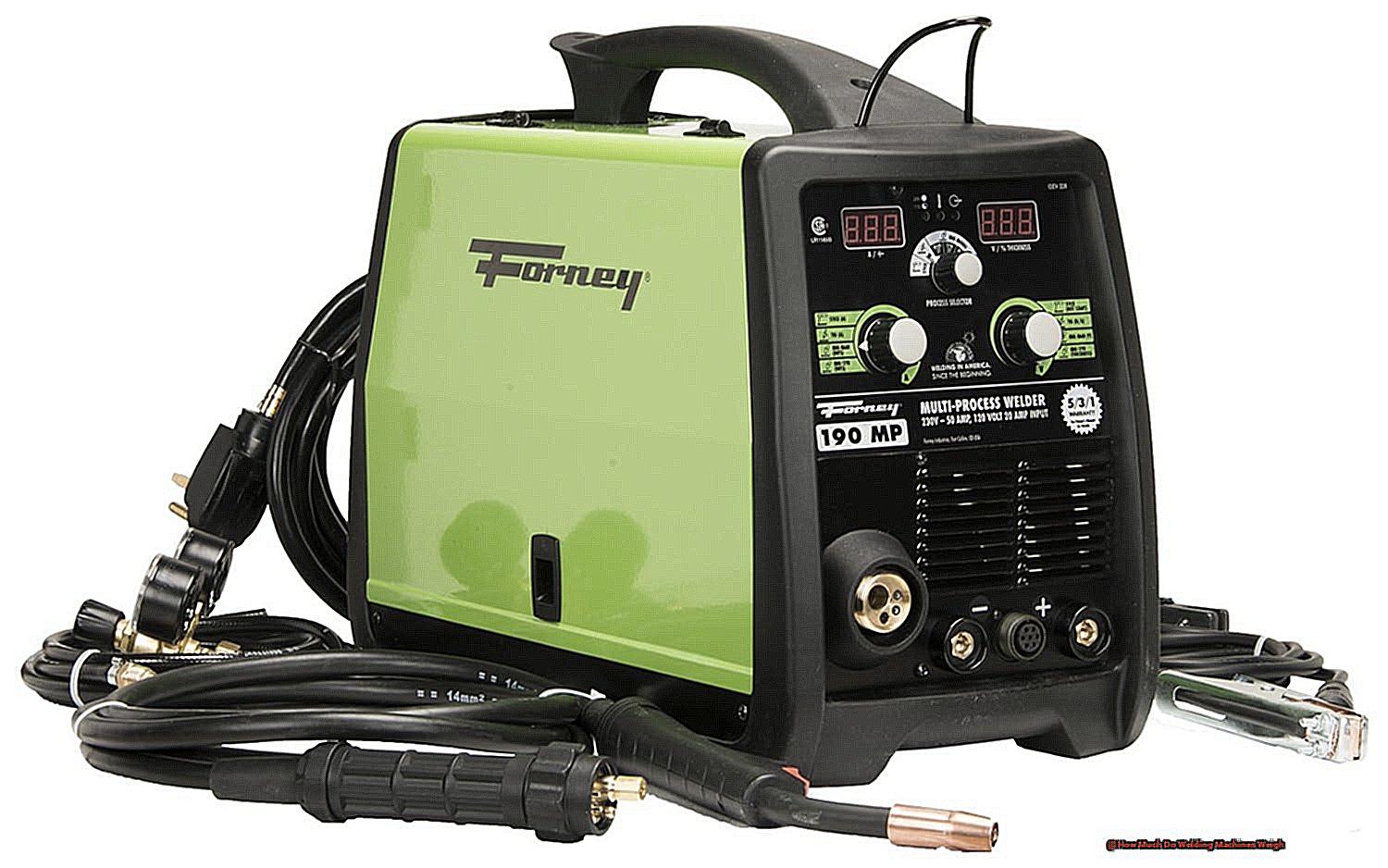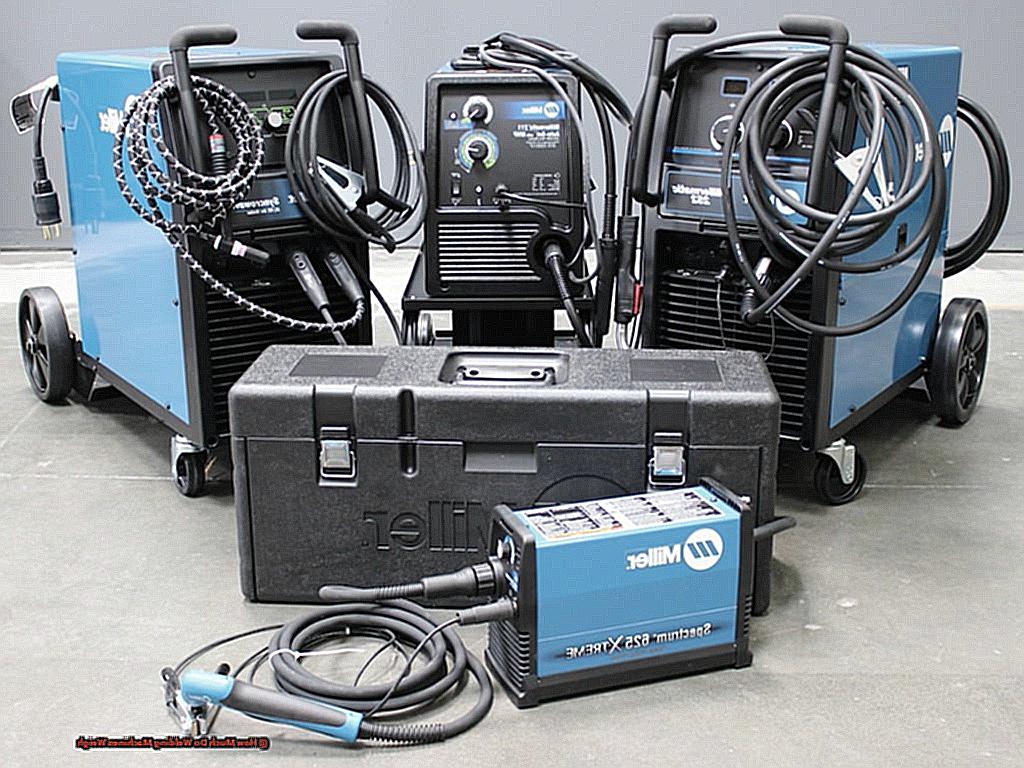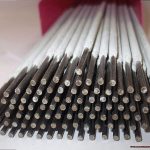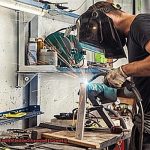Today, we’re shining a spotlight on a crucial yet often overlooked element of welding – the weight of welding machines. While most welders prioritize factors like power, speed, and efficiency when selecting a machine, the weight of the equipment can make all the difference in their experience.
So let’s gear up and take a closer look at why you should pay attention to the weight of your welding machine for your next project.
How Much Do Welding Machines Weigh?
Contents
- 1 How Much Do Welding Machines Weigh?
- 2 Factors That Affect the Weight of Welding Machines
- 3 Types of Welding Machines and Their Average Weight Range
- 4 Stick Welders: The Heaviest Type of Welding Machine
- 5 MIG Welders: Commonly Used in Industrial Settings
- 6 TIG Welders: Precise and Clean Welds for Industrial Use
- 7 Flux-Cored Welders: Portable Options for Light-Duty Tasks
- 8 Conclusion
As a skilled welder, understanding the heaviness of your equipment is crucial for various reasons. Whether you need to transport it to a new location or ensure its compatibility with your vehicle, having this knowledge is essential. In this comprehensive guide, we will delve into all the intricacies of welding machine weight.
First and foremost, it’s vital to grasp that the weight of a welding machine can differ significantly based on its type and size. Smaller and more portable machines will inevitably be lighter than their larger industrial counterparts. Furthermore, the materials used in constructing the machine also play a significant role in its weight. A welding machine made of aluminum will undoubtedly be more lightweight than one constructed with steel.
Another factor that contributes to the weight of a welding machine is its power source. While some machines run on electricity, others utilize gas or a combination of both. Gas-powered machines tend to be heavier due to the added weight of the gas cylinder. In contrast, electric machines are typically lighter and easier to transport.
Now, let’s delve into the average weight range for different types of welding machines. Stick welders, also known as arc welders, are typically the heaviest type of welding machine. They can weigh anywhere from 50 to 100 pounds, depending on their power output and additional features such as wheels or handles for portability.
MIG (Metal Inert Gas) welders are the most commonly used type in industrial settings. They are relatively lightweight compared to stick welders, with an average weight range of 30 to 80 pounds. TIG (Tungsten Inert Gas) welders are also prevalent in industrial settings due to their precision and clean welds. These machines typically weigh between 50 to 80 pounds.
For those seeking a more portable option, Flux-Cored welders are available. These machines weigh around 20 to 30 pounds, making them the lightest of all welding machines.
Factors That Affect the Weight of Welding Machines
Selecting the perfect welding machine can prove to be a daunting task, particularly when one takes into consideration its physical weight. The weight of a welding machine is influenced by various factors, and having a thorough understanding of them can assist in making a well-informed purchase decision.

One of the primary factors that impact the weight of welding machines is the type of welding process utilized. The most commonly used processes include MMA, TIG, and MIG/MAG, each with its own distinct features and capabilities. These processes require varying power sources and components, ultimately affecting the overall weight of the machine.
Another crucial element to consider is the base materials being welded. The thickness of these materials and the length of welds needed can dictate the necessary power and duty cycle for the machine, subsequently impacting its weight. Furthermore, specialized processes like plasma cutting or spot welding may enhance or replace traditional methods, adding to the overall weight of the machine.
When contemplating a welding machine, it is imperative to consider your specific requirements. For some individuals, a multi-process machine may prove to be the most advantageous option, while others may benefit more from a specialized machine. Your role within the company’s operations and intended applications also play a significant role in determining the necessary characteristics of your welding machine.
The quality and arc characteristics also have a direct impact on the productivity and post-treatment time of welding, which can ultimately affect the overall weight of the machine. Size, mobility, location, and accessories should also be taken into account for exceptional welding needs.
End user satisfaction is another crucial consideration when selecting a welding machine. User-friendly interfaces, multiple language options, and ease of use can make all the difference for multiple users. It is always recommended to test out a machine through demonstrations before making a purchase to become acquainted with its features.
Additionally, it is essential to factor in the availability of service points, consumables, spare parts, and warranty policies.
Types of Welding Machines and Their Average Weight Range
The world of welding is complex and involves the fusion of metal pieces through the use of intense heat. This process plays a vital role in many industries, from construction to automotive manufacturing. However, with a variety of welding machines available, choosing the right one can be perplexing. Let’s delve into the average weight range for different types of welding machines and help you find the perfect match for your specific needs.
The most commonly used welding machine is the Stick or Shielded Metal Arc Welding (SMAW) machine. It is a versatile, cost-effective, and user-friendly option, making it a top choice among welders. On average, Stick machines weigh between 50 to 100 pounds, depending on their power output and features. These machines tend to be on the heavier side due to their durable construction and capability of handling heavy-duty tasks.
Another popular option is the Gas Metal Arc Welding (GMAW) or MIG machine, which is recommended for beginners due to its easy-to-use nature and versatility. These machines have an average weight range of 30 to 80 pounds, making them relatively lightweight when compared to Stick machines.
If efficiency and handling thicker metals are your priorities, then Flux-Cored Arc Welding (FCAW) machines are worth considering. They have an average weight range of 20 to 30 pounds, making them more portable than other types of welding machines.
For those seeking precise and clean welds, Gas Tungsten-Arc Welding (GTAW) or TIG machines are an excellent choice. These machines offer a high level of control and can work with a wide range of metal thicknesses. Their average weight range is between 50 to 80 pounds, similar to Stick welders.
When selecting a welding machine, it is essential to consider factors such as the type of metal, material thickness, and desired weld quality. With these considerations in mind, you can find the perfect welding machine to meet your specific needs.
Stick Welders: The Heaviest Type of Welding Machine
Out of all the types of welding machines available, stick welders, also known as shielded metal arc welding (SMAW) machines, stand out as the bulkiest. With an average weight of 50-60 pounds, they are truly the heavyweight champions in the welding industry.
But what makes stick welders so heavy? Let’s delve into their features and benefits to understand why they are the heaviest type of welding machine on the market.
The first thing to take note of is that stick welders are dense due to their construction and functionality. They consist of a power source, electrode holder, and ground clamp, all of which contribute to their overall weight. However, there are more specific reasons behind their bulky build.
One major factor is the use of a consumable electrode that melts during the welding process. This electrode is made of metal and can weigh anywhere from 1-5 pounds depending on its size and type. As a result, the machine needs to be sturdy and hefty enough to support the weight of the electrode.
Moreover, stick welders boast a larger transformer compared to other types of welding machines. This component is responsible for converting high voltage to a lower amperage suitable for welding. While crucial for creating a stable arc, the transformer also adds significant weight to the machine.
Furthermore, stick welders are designed to handle thick and heavy materials such as structural steel. To do so, they require higher amperage and longer welding time, which means they need to be more robust and dense in order to withstand these demands.
But don’t let their weight intimidate you. Stick welders are still a popular choice among professionals and hobbyists due to their versatility and affordability.
MIG Welders: Commonly Used in Industrial Settings
When it comes to materials, mild steel may be the go-to for hobbyist welding, but true professionals work with a variety of metals, including aluminum and stainless steel. And with each different material comes the need for specific adjustments to voltage and wire speed. From thin sheet metal to thick plates, every project requires careful consideration and fine-tuning of these settings to achieve optimal results.
But it’s not just about settings. Shielding gas is also a vital component in MIG welding. It acts as a protective barrier, preventing oxidation and ensuring a strong bond between the weld and the surrounding air. And let’s not forget about surface preparation – clean surfaces are crucial for producing clean welds and avoiding excessive spatter.
Out of all the settings, voltage and wire speed hold the most weight when it comes to MIG welding. These two controls determine the width and penetration of the weld bead. While manufacturers may provide recommendations, trial and error may also be necessary to find the perfect balance for each unique welding project.
Luckily, advancements in technology have made MIG welding more accessible for beginners. State-of-the-art MIG welders now feature intelligent settings that automatically adjust voltage and wire speed based on the material being welded. But beware – there are no universal settings that work for all machines. It is still essential to have a thorough understanding of your machine’s controls to achieve optimal results.
In addition to its versatility, MIG welders also offer efficiency in industrial settings where time is money.
TIG Welders: Precise and Clean Welds for Industrial Use
When it comes to welding for industrial use, exactness and immaculateness are paramount. This is where Tungsten Inert Gas (TIG) welding shines. TIG welding is a methodical and unpolluted welding technique that offers numerous advantages over other methods.
One of the primary merits of TIG welding is the first-rate weld it produces. The welds are robust, seamless, and devoid of splatter and slag. This is accomplished by astutely regulating the current, gas flow, arc length, and filler metal. With TIG welding, you have complete mastery over all of these variables, resulting in a meticulous and uniform weld every instance.
TIG welding is also a versatile option, as it can be employed on various metals, thicknesses, orientations, and configurations. It’s an exceptional choice for projects that involve joining different types of metals together. Moreover, TIG welding is smoke-free, fume-free, and spark-free, making it an eco-friendly option.
In traditional welding methods, filler material is often necessary to create a durable bond between metals. However, with TIG welding, filler material is superfluous. This not only saves time and money but also yields a spotless weld with minimal distortion.
A pivotal element of TIG welding is the foot pedal. This allows for superior command over the welding process and can be tailored for different materials and thicknesses. With this level of precision and authority, TIG welding is particularly suited for thin materials and can produce superb weld quality with minimal distortion.
In summary, if you desire exacting and pristine welds in your industrial ventures, TIG welding is the way to go. With its versatility, cleanliness, and ability to produce top-notch welds without filler material, it’s no surprise that TIG welding is a favored choice among professionals.
Flux-Cored Welders: Portable Options for Light-Duty Tasks
When it pertains to the art of welding, having a portable machine is an absolute must for tackling light-duty tasks. Whether you are a skilled welder or a DIY enthusiast, possessing a compact and lightweight machine can make all the difference in completing the job effectively and safely. That is why we have assembled a list of the top portable flux-cored welders for the upcoming year of 2022.
However, before we delve into our recommended options, let us first discuss why portable welding machines are an essential addition to your toolkit. These machines are ideal for on-the-go repairs, particularly when traditional setups are not feasible. Additionally, they are perfect for individuals who prefer to handle their own repairs rather than relying on potentially overcharging professionals.
Now, let us explore our top picks for portable flux-cored welders. Our list features selections from reputable manufacturers such as Miller and Lincoln, renowned for their high-quality and dependable welding machines.
Lincoln Electric K2278-1 Handy Core
The Lincoln Electric K2278-1 Handy Core is a compact and lightweight option that can weld up to 1/8 inch of mild steel. It also comes with a one-year warranty, making it an excellent choice for both professionals and DIY enthusiasts.
Millermatic 252
Next up is the Millermatic 252 from Miller Welding Machines. This machine boasts useful features like infinite voltage control and Auto-Gun Detect, making it user-friendly and energy-efficient. It also comes with necessary accessories, ensuring you have everything you need to get started.
MagicWave 230i Welder from Fronius
For professional welders, the MagicWave 230i Welder from Fronius is a fully digitized option equipped with non-contact arc ignition and quick setup capabilities. It also offers the ability to customize welding requirements, making it a top pick for precision and efficiency.
Conclusion
In conclusion, the weight of a welding machine may seem like a minor detail compared to other factors such as power and efficiency. However, it plays a crucial role in your overall welding experience. From ease of transportation to compatibility with your vehicle, understanding the weight of your welding machine is essential for any welder.
As we’ve explored in this blog post, the weight of a welding machine can vary greatly depending on its type, size, materials used, and power source. Stick welders are typically the heaviest option due to their sturdy construction and ability to handle heavy-duty tasks. On the other hand, MIG welders are commonly used in industrial settings and have an average weight range of 30 to 80 pounds. TIG welders offer precise and clean welds for industrial use but weigh between 50 to 80 pounds. For those looking for a more portable option, Flux-Cored welders weigh around 20 to 30 pounds.
When choosing a welding machine, it’s crucial to consider various factors that can affect its weight. These include the type of welding process utilized, base materials being welded, specialized processes involved, and user satisfaction. It’s also essential to understand your specific requirements and test out machines before making a purchase.
Ultimately, having a thorough understanding of how much welding machines weigh can help you make an informed decision when purchasing one for your next project. So whether you’re a skilled professional or a DIY enthusiast searching for a portable option, be sure to consider the weight of your welding machine for optimal results.





